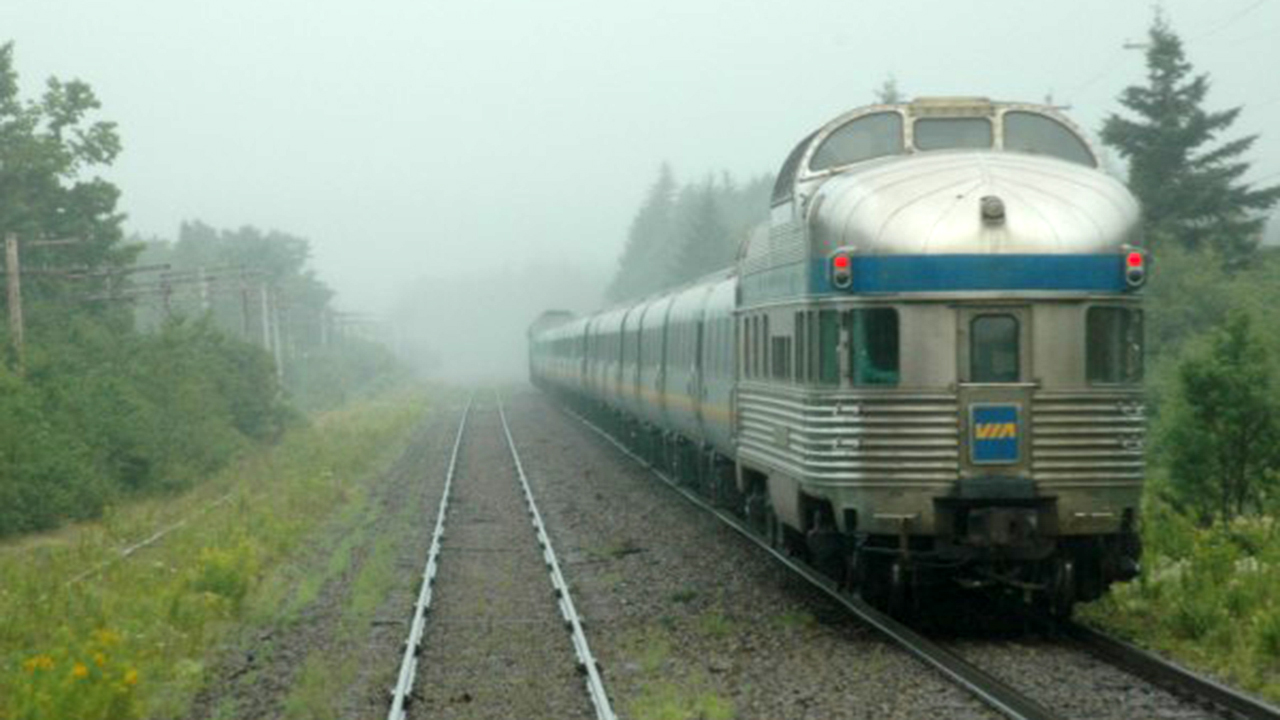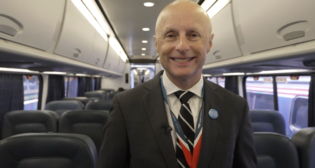
VIA Rail Adventures: Atlantic Canada’s Only Passenger Train
Written by David Peter Alan, Contributing Editor
Wilimedia Commons/Alan Macek
Sixth and final of a series: During August and early September of 2023, I spent much of a five-week period on VIA Rail, riding that railroad’s obscure “Adventure” routes. I had made it as far west as eastern Saskatchewan on the way to VIA Rail’s northernmost terminal at Churchill, Manitoba. I rode classic “Budd cars” in northern Ontario and trains in Quebec that consisted of a locomotive, a baggage car, and a single coach. I had completed all the system’s mileage on Sept. 1, when Train 601 pulled into Jonquiere, Quebec.
But there was still one train I wanted to ride again: the Ocean, Atlantic Canada’s last passenger train.
With the exception of the obscure Quebec, North Shore & Labrador in the frigid mining country of northern Quebec and Labrador, the Ocean is the only passenger train that runs east of Quebec City. I had not planned to ride it, since I had enjoyed wonderful rides on it years ago, as well as one that was excruciatingly uncomfortable. When I learned that there is still one coach in the consists from the “HEP-1” (Head-End Power) class from the 1954-vintage Budd-built equipment from the original CP Canadian, I booked a round trip to Halifax and stressed the importance of riding in that particular car.
On Saturday, September 2, I walked around the Old Quebec, the historic part of Quebec City, located within the city’s walls. On Sunday, I rode a tourist railroad running a corridor-length route: the Train de Charlevoix, from a station at the bottom of scenic Montmorency Falls, along the south shore of the St. Lawrence River to La Malbaie. I reported on those adventures last fall. After the ride, it was time to take the bus back to downtown Quebec City, grab a bite to eat, and walk to historic Palais station for the start of my final “Adventure on VIA Rail” for this series.
The beautiful station building still stands, but it is shadow of its former self on the inside. Canadian National Railways (CN) had shut it down in 1976 and built a new station at Ste. Foy, west of Quebec City, as a new terminal for corridor trains serving Montreal. The historic station came back in 1985, but now there are only two relatively short tracks approaching the building from the side. For the five daily arrivals and departures of the Montreal trains, that is sufficient. At least when I was there, what the station lacked in physical facilities it offered in customer service. I was having trouble with the tiny hinge that held the temple piece (which hangs over the ear) on my glasses to the main frame. Hugues Tremblay, the Service Agent at the station, who had been a jeweler, managed to repair my glasses during a lull in his other duties. His repair lasted not only long enough for me to get back home, but for almost five months. As far as I am concerned, that’s customer service in the best railroad tradition!
The other riders and I were there not to catch the train, but to take two chartered vans to Ste. Foy, where the Ocean now stops. There is an extra fare for the van ride, but it is significantly quicker than taking a local bus. CN’s Halifax trains never stopped at Quebec City. When I first rode the Ocean 25 years ago, it ran along the north shore of the river and stopped at Levis, which is still accessible by ferry from Quebec City. A few years later, the train was rerouted to stop at Ste. Foy instead.
Long Ride on a Relatively Long Train
Throughout this series, there has been a recurring theme on VIA Rail of “two trains in one.” The two trains that serve Quebec north of Montreal run combined until they split at Hervey Junction. The transcontinental Canadian practices ironclad class-segregation, where there is absolutely no contact allowed between the traveling classes, and passengers in coach are not allowed even to purchase meals and are limited to barely-edible snacks for up to four days. That theme applies to the Ocean, too. The same dining practice is enforced there, but the running time is scheduled for 22 hours, end to end. There is another reason for describing the train as “two trains in one” and that is its unusual consist.
That became obvious as the Train 14 pulled onto the platform on its way to Halifax. Behind the two F40PH-2 locomotives came a train of cars built by Metro-Cammell in the mid-1990s for a proposed Eurostar overnight train between London and the Continent, which never ran. Instead, the equipment was sold to VIA Rail and underwent some modifications. The cars were based on the British Rail Mark 4 design, with a narrower loading gauge than conventional equipment running in the United States and Canada; an undesirable feature, as I had learned on a previous trip from Halifax to Montreal years ago.
My first trip on the Ocean took place in 1998, and it was magnificent. The entire consist sported the HEP (Head End Power) cars from the old CP Canadian consists that were built by Budd. The coaches were comfortable, it had a dome lounge car (VIA Rail calls them “Skyline” cars), a full dining car that served freshly-prepared meals to both sleeping car and coach passengers, and a round-end observation car (called a “Park” car) at the hind end. Sadly, that wonderful train was not to last much longer.
The British equipment, which VIA Rail semi-humorously calls “Renaissance” equipment, made its debut in 2002. After those cars were introduced, some runs still featured HEP-1 cars in their consists. I managed to make a round trip to Moncton (for the specific purpose of visiting a place in New Brunswick) a few years later and caught that equipment in both directions. On a later trip to Halifax, I was not so lucky. After a pleasant ride to Halifax, I sat in a Renaissance coach in Train 15 to Montreal, in a fixed seat that did not recline and had little headroom or legroom. There was little space for bags, and I had to ride all the way to Montreal in what VIA Rail calls “Comfort Class,” a superb example of Orwellian doublethink. That is why I insisted in riding in the only HEP-1 coach in the current consist on this trip. The lounge car did not offer much respite, either. Unlike the Budd-built lounge cars with domes on the Canadian or the Hudson Bay to Churchill, or the Amtrak Superliner lounge cars on its Western trains, the “Renaissance” lounge cars offered only 13 places to sit and very little table space.
The British equipment was placed at the head of the consist. That section of the train included a baggage car, four sleeping cars, a lounge car for sleeping-car passengers, a dining car (with pre-prepared food that was heated and served), a lounge car for coach passengers, and two of the cramped, uncomfortable coaches that I just described.
The next car was empty, except for a cage for bags, a few pictures on the wall, and a carpeted floor and bulkheads. There were no seats or other furniture. VIA Rail called the car a “transition car”; ostensibly because it has British-style coupler on one end and a traditional knuckle coupler used on conventional Canadian and U.S. equipment on the other end. Someone called that car a “crush car,” which appeared to reveal another reason for placing it there. Behind it were five classic HEP cars: a single coach (where I sat), three sleeping cars, and a baggage car bringing up the rear. Gone was the vintage observation car, and with it the view from the rear of the train. That particular downgrade was blamed on new operating procedures at Halifax. The post-COVID Ocean was still a long train, but nothing like VIA’s version of a CN legend that I had ridden 25 years before. The HEP-1 coach was full, but my seat was comfortable.
Steve Barlock, the Service Manager (and boss of the train, since VIA Rail no longer has “conductors”), is the senior employee on the roster at the Halifax crew base, with 32 years on the railroad. He remembered employees who started before VIA Rail was founded, when CN ran the train. He told me: “Ridership has gone through the roof this summer” and characterized the increase as “revenge travel at its best”; adding that the coaches were sold out with 152 passengers. Last summer’s ridership stood in marked contrast to the time when the COVID-19 virus was causing havoc on the railroad and just about everywhere else, too. Barlock saidthat, when service came back after being suspended, the train only made one round trip per week, and there were only seven people working on the Halifax crew roster.
He also mentioned some challenges that come with the current equipment and operation, such as limitations on how certain cars can be positioned in the consist because it uses two different coupling systems. He said that the “transition car” is needed for crash-worthiness in case of an accident, because the vintage cars at the rear of the train are heavier than the British cars in front of them. He noted that CN had removed some sidings, which made operations more difficult, but also complimented the host railroad for an “amazing effort” that resulted in service being restored only three days after 75 feet of track had recently been washed out near Truro, the first stop north of Halifax on the way to Montreal.
The ride on the Ocean is not particularly scenic, although the scenery is not unpleasant. The train travels along the St. Lawrence River in eastern Quebec during the night in both directions, so what we missed is probably more interesting than what we saw. There are a few towns visible along the route, some with beautiful historic stations. The scenic highlight of the route was a brief view of sunset over the Bay of Fundy. That view, while spectacular, was only an artifact of the train running as far behind schedule as it did. Instead of arriving in Halifax at 5:50 PM as advertised, it did not arrive until 8:45.
Atlantic Canada’s Biggest City
Halifax is Nova Scotia’s capital and the largest city in the region, with a population of about 440,000, according to the 2021 census. It was founded as a military outpost in 1749, and it is located on the south shore of the peninsula that forms most of the province. It is an attractive city, with a walkable downtown area that includes scenic streetscapes with historic buildings. The Victorian-style Public Garden is famous, as is the campus of Dalhousie University, which was founded in 1819. One of the city’s most-active spots in the summer is the boardwalk at the harbor, and the most-famous nautical attraction is the Maritime Museum of the Atlantic. Its exhibits include a reproduction of a ship’s store, an exhibit about the Titanic with an original deck chair from the ill-fated ship, and another that tells the story of the explosion that leveled much of the city in 1917, when a collision caused a munitions ship to blow up. It was the most-severe non-natural disaster in history up to that time, and until the United States dropped two atomic bombs on Japan 28 years later and brought World War II to an end.
The Art Gallery of Nova Scotia is the city’s art museum. There is also an immigration museum at Pier 21, which was Canada’s equivalent to Ellis Island for the United States. For visitors willing to take the steep walk up Citadel Hill, the old fort at the top is now a military museum. The exhibits are interesting, and the view of the rest of the city is the best in town. One of the city’s most famous buildings, the Town Clock, is located on the path coming down from the Citadel. It looks like a three-tiered wedding cake on top of a pedestal, and it has been keeping time since 1803.
There is no rail transit in Halifax, or anywhere else in Canada east of Montreal. Aside from the city bus system, there is a ferry to Dartmouth, which is also operated by Halifax Transit. The Alderney Ferry runs a full-service schedule, including on weekends, but ending shortly before midnight. The Woodside Ferry runs less often, on weekdays only, and not past mid-evening. The ride is worth taking, and a walk around Dartmouth is an interesting component of a Halifax itinerary.
The food scene in Halifax does not rival that in bigger cities like Montreal or Toronto. The city’s most famous specialty is donair, with meat similar to Turkish donner kebob or Greek gyro, and served on pita bread with tomatoes and onions. Instead of the yogurt-based tzatziki sauce often found in places like Chicago and New York, the sauce on a Halifax donair is sweet, garlicky, and made with condensed milk. Local Haligonians (as they call themselves) love it, but it could be an acquired taste for visitors. Another local favorite is seafood chowder, made in the New England style. Due to the city’s diverse population, there are plenty of ethnic restaurants, too.
I arrived in town on Labor Day (the same Monday as in the U.S.) and spent Tuesday and Wednesday morning walking around town, seeing the Citadel, and taking a side trip to Dartmouth on the ferry. The Citadel also continues a long-running custom in the city: firing the Noon Gun. When I heard it on Wednesday, I was close enough to the station to know I would be there on time for the 1:00 departure of Train 15 for Montreal. The station and the Nova Scotian Hotel next door were both built by CN. The station opened in 1928, and the hotel in 1930. Both still soldier on, but they have seen better days. The station once hosted CN trains to other places in Atlantic Canada, as well as Montreal. The Dominion Atlantic Railroad, a CP subsidiary, used it, too. On the other side of a passageway, the hotel has been “modernized” and seems to have lost some of its grandeur. It still has its history, such as the days when its laundry also served CN sleeping and dining cars, and its kitchen prepared food that was served on the trains. Today the station recreates a bit of its former glory and anticipatory atmosphere only three times a week: at midday on Wednesdays, Fridays and Sundays. That is when eager passengers wait in boarding lines for sleeping cars and coaches to get on the Ocean, probably much as they have done since the Intercolonial Railway, CN’s predecessor in that part of Canada, first ran the train in 1904.
The ride from Halifax to Montreal was much like the ride in the other direction, except that the train was not as crowded. Although it was scheduled to arrive in Montreal shortly before 10:00, it finally got there at 1:55; four hours behind schedule. I spent the rest of Thursday riding pieces of the Metro system that I had not ridden for many years and enjoying some of the city’s local food specialties. My final destination in Montreal was the bus terminal, where I caught an overnight bus on New York Trailways back to New York City, wishing that Amtrak’s Adirondack were back in service. At that time, it was still suspended. It would not come back until later in September.
It was almost a spur-of-the moment decision to ride the Ocean and visit Halifax again, and the train did not bear enough resemblance to the experience it had delivered twenty-five years before. There was no more observation car, and the experience of enjoying freshly cooked meals in the vintage dining car was gone, too. At least there was one comfortable coach where I could ride, and the crew members were polite and personable, in the great railroad tradition that was observed on most, but not all, of Canada’s Railroad. Still, it felt like a long trip. Maybe the fact that the trains were late contributed to that feeling, but my previous trips on that train never felt that way, except the one time when I ended up in an incredibly uncomfortable “Renaissance” coach all the way from Halifax to Montreal.
My adventures on VIA Rail were over. Before I took VIA Rail’s version of an Ocean’s “land cruise,” I had met my goal of having ridden the entire system. I have more plans to visit Canada again, including a one-way journey from Vancouver to Toronto this spring. I’ll be in a lower berth, meeting my fellow passengers (who will deserve respect, according to VIA Rail’s attitude), and enjoying freshly prepared food in the dining car; an experience no longer available on Amtrak, or apparently anywhere else on VIA Rail, either. There are more things I want to see in and around Toronto, Ottawa, Montreal, and Quebec City, so I will probably ride some of VIA Rail’s corridor trains this summer.
Then there are the obscure trains in Canada, which I hope to ride someday. The White Pass & Yukon, based in Skagway, Alaska, would go well with a trip on the Alaska Railroad, which I hope to take next year. The Quebec, North Shore & Labrador with its Native-owned component, the Tshiuetin Railway in northern Quebec and Labrador would be an adventure. The Keewatin Railway between The Pas and Puckatawagan, Manitoba is the most remote. I anticipate more, but different, adventures in Canada.

David Peter Alan is one of America’s most experienced transit users and advocates, having ridden every rail transit line in the U.S., and most Canadian systems. He has also ridden the entire Amtrak and VIA Rail network. His advocacy on the national scene focuses on the Rail Users’ Network (RUN), where he has been a Board member since 2005. Locally in New Jersey, he served as Chair of the Lackawanna Coalition for 21 years, and remains a member. He is also Chair of NJ Transit’s Senior Citizens and Disabled Residents Transportation Advisory Committee (SCDRTAC). When not writing or traveling, he practices law in the fields of Intellectual Property (Patents, Trademarks and Copyright) and business law. Opinions expressed here are his own.



